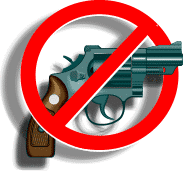List of Prohibited Items

The goal of the Court Security Department is to make the workplace a safe environment for all employees. In pursuit of this goal, the following is a list of weapons and items, by category, prohibited within the Arizona State Courts Building.
Level One - the highest level of security in the Arizona State Courts Building. All court, administrative, and public hearings held within the building are considered Level One for security purposes. The categories below are an expanded list of potential weapons and items prohibited in the building, under Supreme Court, Administrative Office of the Courts, Security Policy 4.11
Prohibited Deadly Weapons
A.R.S. §13-3101.1 - Describes a deadly weapon as a firearm, or anything designed for lethal use. Examples include, but are not limited to:
Box Cutters, Butterfly Knives, Firearms, Daggers, Knives, Pen Guns, Razors, Razor Blades, Straight Razors, Swords.
Prohibited Deadly Explosives
A.R.S. §13-3101.3 - Describes an explosive as any dynamite, nitroglycerine, black powder or other similar explosive material including plastic explosives but does not mean or include ammunition or ammunition components such as primers, percussion caps, smokeless powder and black powder used for hand loading purposes. These items are listed under the Prohibited Potential Weapons category.
Black Powder, Blasting Caps, Dynamite, Fireworks, Plastic Explosives, Nitroglycerine
Prohibited Flammable Liquids
A.R.S. §28-602 - Flammable liquid means any liquid which has a flash point of less than 100 degrees Fahrenheit and which is defined in the 49 Code of Federal Regulations, Part 173. Examples include but are not limited to:
Acetone, Alcohol, Ether, Gasoline, Lighter Fluid, Paint Thinner, Sterno, Turpentine
Prohibited Caustic Alkalis and Acids
A.R.S. §36-1101 - Describes dangerous, caustic or corrosive substances as:
- Acetic Acid
- Ammonia Water
- Arsenic
- Carbolic Acid
- Hydrochloric Acid
- Hypochlorous Acid
- Nitric Acid
- Oxalic Acid
- Potassium Hydroxide
- Silver Nitrate
- Sodium Hydroxide
- Sulfuric Acid
Prohibited Weapons, Contraband and Potential Weapons
A.R.S. §13-3101.7 - Describes prohibited weapons as:
Bombs, Grenade, Explosives, Incendiary Devices, Land Mine, Poison Gas, Rockets
A.R.S. §13-2501 - Describes contraband as:
Dangerous Instruments, dangerous Drugs (speed, LSD, etc.), Deadly Weapons, Explosives, Narcotic Drugs (heroin, cocaine, etc.), Obscene Materials, Marijuana
The following is a list of items that could be considered as potential weapons and will be prohibited at all hearings. The list includes but is not limited to:
Ammunition, Ammunition Components (primers, percussion caps, smokeless powder, black powder used for hand loading), Baseball Bats, Batons, Bicycle Chains, Black Jacks, Brass knuckles, Bullets, Bullet Clips, Clubs, Cork Screws, Crochet Hooks, Darts, Facsimiles of Weapons, Gun Lighters, Hammers, handcuffs, hatchets, Hors Shoes, Ice Picks, Knitting Needles, Letter Openers, Lock Picks, Meat Cleavers, Martial Arts Devices, Multi-Blade Knives, Ninja Pins, Nail Files (4" or longer), Plastic Knuckles/Brass, Safety Pins (large), Scissors, Spikes, Stakes, Syringes, Throwing Stars, Tools, Toy Guns/Weapons
Prohibited Religious Items
There are many miscellaneous religious items that could be used as a potential weapon. Security will determine if an item is to be allowed into a secure area. Certain religious articles may be considered by the holder as sacred. Many times the holder will request that the item not be unsealed or opened. They believe the object will lose its religious power if tampered with. When this occurs, security will physically examine or x-ray the item and determine its admissibility into the secured area. Examples of such items include:
- Small religious objects worn or carried as charms to avert evil and bring good fortune.
- Leather pouches (usually worn around the neck)
- Medicine bags (used in Native American religious practice